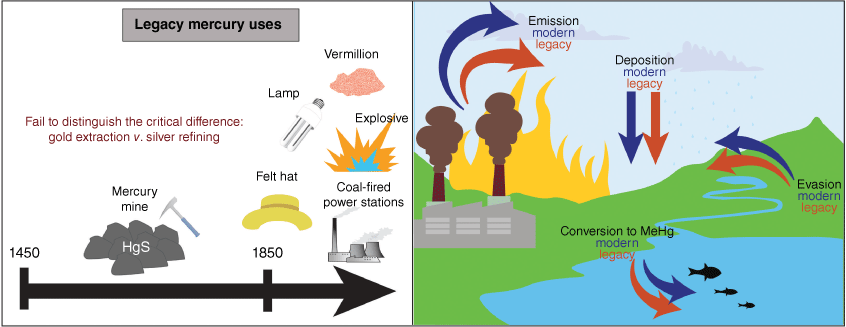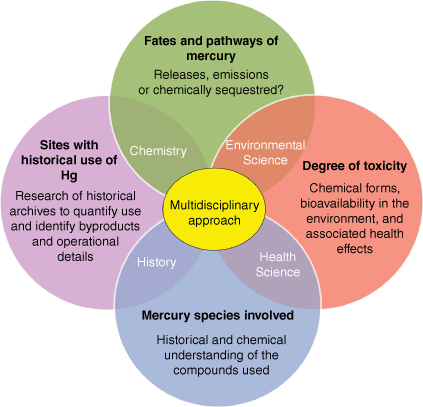From chemistry to culture: the need for an integrated approach to mercury research and policy making
Larissa Schneider A * and Saul Guerrero A
A * and Saul Guerrero A
A
Abstract
This paper highlights the need for an integrated approach to mercury (Hg) research, examining its extensive anthropogenic use and lingering impact on ecosystems. From ancient cinnabar pigments to industrial-scale applications, mercury’s unique properties have driven diverse uses with significant environmental consequences. Legacy Hg within the global biogeochemical cycle emphasises the importance of investigating its historical uses and emissions alongside their modern implications. By bridging chemistry, history and policy, this work advocates for multidisciplinary strategies to mitigate Hg pollution and develop sustainable approaches for managing its global impact.
Mercury (Hg) has been extensively used throughout human history, leaving a persistent environmental legacy that continues to present challenges for pollution management and public health. This highlight focuses on the importance of a multidisciplinary approach to enhance our knowledge of mercury’s historical uses and emissions, supporting more effective strategies to address its environmental and societal impacts.
Contemporary emissions of mercury (Hg) prompt significant scientific debate and concern. However, these concerns represent only a subset of the broader historical perturbations induced in mercury’s biogeochemical cycle by anthropogenic activities. For millennia, humans have harnessed the distinctive physicochemical properties of Hg in a plethora of applications, including but not limited to health, art, extracting gold and refining silver, agrochemicals, and sundry industrial and manufacturing processes for various consumer products (Parsons and Percival 2005; Brooks 2012; Guerrero and Schneider 2023). This extensive exploitation reflects mercury’s multiple roles in both cultural and technological spheres throughout human history.
Mercury is one of the oldest chemical elements known to have been used by humans (Parsons and Percival 2005). Its use dates back to c. 4000–3000 BCE when its most common chemical compound, mercuric(II) sulfide (HgS) or cinnabar (a reddish pigment), was used in the Italian peninsula (modern-day Italy) and the Iberian peninsula (modern-day Spain) as a preservative for human bones during the Neolithic Age (Goldwater 1972; Martín-Gil et al. 1995). The presence of both Hg and HgS in ancient artefacts and historical sites indicates that it was known and used by several ancient societies (Brooks 2012).
Mercury’s utilisation in an industrial scale became an early historic reality following the discovery of the New World, which harboured the world’s largest primary deposits of silver ores. In 1591, the annual production of Hg at Huancavelica (modern-day Peru) and imports from Europe reached a peak of 530 tonnes, all destined to refine silver in the Vice-Royalty of Peru, mainly from the vast silver deposit of Potosí (modern-day Bolivia) (TePaske 2010). The widespread use of Hg in the refining of sulfidic silver ores in the Hispanic New World between 1550 and 1800 led to an increase of more than three-fold in the global Hg production during the same period (Hylander and Meili 2003). This unprecedented historical surge highlights mercury’s critical role in the development of novel metallurgical techniques in Hispanic America (Fig. 1).
Illustration of the simplified mercury (Hg) cycle, highlighting the contribution of legacy Hg to the present-day cycle.

In the 19th Century, the utilisation of Hg broadened considerably, extending beyond the production of silver and gold to encompass a significant increase in the synthesis of vermilion pigment, and the manufacturing of felt hats, among additional new uses (Fig. 1). This era also marked the rise of significant new Hg markets, notably China, Europe and India (Guerrero and Schneider 2023). Concurrently, the onset of industrialisation introduced additional complexities into the Hg cycle. Notably, industrial activities unrelated to direct Hg use, such as the combustion of coal in power plants and metal smelters, and an overall growth in industrial output increased Hg emissions markedly by the early 20th Century. To this must be added the dangerous and unregulated use of Hg in artisanal and small-scale gold mining (ASGM) in many developing economies around the world, which by 2015 represented the single most important source of emissions (37.7%) of anthropogenic Hg to the environment (UN Environment Programme 2019).
Mercury’s lingering impact: how historical use continues to affect modern environments
Mercury historically extracted and utilised transitions through a series of chemical transformations that alter its toxicity and environmental transport mechanisms (Fig. 1). Owing to its inherent chemical and physical properties, once liberated from geologic reservoirs, Hg persistently recirculates through atmospheric, oceanic and terrestrial systems over durations extending from decades to centuries (Obrist et al. 2018). As a result, Hg deposition in the environment today stems not only from current anthropogenic sources but also from legacy Hg emissions that continue to circulate within the global Hg cycle (Fig. 1). Thus, an accurate understanding of mercury’s historical applications and the tracking of Hg residuals from past utilisations is essential for developing effective environmental policies and for the strategic management of mercury-related environmental impacts.
The global distribution of legacy Hg sites, however, remains largely undetermined. Until this distribution is mapped for historical markets in regions such as China, India, Europe and North America, and a comprehensive account of the various byproducts of its use is provided, the modern impact of pre-1900 legacy Hg will remain unclear.
Assessing mercury pollution: overcoming challenges through a multidisciplinary approach
There is no simple way to characterise the use of Hg throughout centuries, and even less to quantify its historical impact on the environment, both then and now in the guise of legacy Hg. Since, for very valid reasons, Hg is the usual suspect in any study of the negative effects on our environment from anthropogenic activity, it requires a careful multidisciplinary approach to avoid generalisations that fail to take into account the complex chemistry involved in many of its principal historical uses, the avoidance of anachronistic comparisons that fail to distinguish the critical difference between gold extraction and silver refining with Hg, and even the correct use of technical terms in descriptions of its uses.
A cautionary tale arises from the consequences of underestimating the care with which Hg was handled and used in silver refining, procedures described in detail in primary historical texts and quantified in accounting records from the 19th Century (Guerrero 2017). By omitting firsthand historical evidence and hard data, together with the chemistry of a very complex chemical process, the quantity of its emissions from silver refining to the environment prior to 1900 has been overestimated (Guerrero and Schneider 2023).
Furthermore, the toxicological effects of Hg and its compounds should be clearly differentiated. Liquid Hg, volatilised Hg, HgS, calomel (Hg2Cl2), mercuric chloride (HgCl2) and various methylated compounds of Hg have quite different degrees of toxicity, so the environmental relevance of flagging the presence of one or the other in historical sites can vary substantially. The magnitude of its historical use should also be clearly specified alongside the type of Hg species involved. Thanks to the effort by the Spanish Empire to document in detail its activity in the New World, we have a fairly good picture of the consumption of Hg up to the early 1800s, with the important caveat that we will never know how much silver was trafficked as contraband. However, for the 19th Century, we have yet no idea as to the multiple Hg mass balances involved in the global production of vermilion, felt hats, medicines, gold production and even silver refining.
Historical and scientific synergy for a comprehensive understanding of mercury’s effects
Modern science and careful historical research need to work hand in hand to establish a better picture of its historical impact. Given the role of silver refining with Hg in the potential generation of legacy Hg, the absence of archeometallurgical research into this refining method is striking. Although smelting with lead and the saigerprozess have been recreated in order to better understand their working (L’Héritier and Téreygeol 2010), no attempt has been made to recreate in the field the hydrometallurgical extraction by chloride leaching of silver using Hg otherwise misleadingly known as the amalgamation or patio process, nor to follow the lifecycle of HgS in the soil. The only recent attempt at a bench scale reconstruction using pure compounds was undertaken 25 years ago, with very useful results (Johnson and Whittle 1999). A similar lack of data applies to the industrial use of Hg to produce vermilion, in the production of felt hats, of Hg fulminate for explosive shells, and other uses. Closer in time, field studies of Hg deposition from the atmosphere need to widen the geographical net to encompass regions of China, India and Europe where Hg was used in significant amounts in the 19th Century.
Ultimately, understanding mercury’s intricate history and its enduring environmental impact necessitates an integrated, multidisciplinary approach that bridges chemistry, environmental science, history and health (Fig. 2). Mercury’s unique physicochemical properties have facilitated its diverse applications across millennia, leaving a legacy of environmental perturbations that continue to challenge modern governance and scientific inquiry. The persistence of legacy Hg within the global biogeochemical cycle emphasises the importance of contextualising historical usage patterns and distinguishing between its chemical forms to inform current risk assessments and mitigation strategies.
A multidisciplinary approach, incorporating discipline-specific factors, is essential for understanding the toxicological and environmental effects of legacy mercury (Hg).

By combining rigorous historical analyses with cutting-edge scientific methodologies, researchers can more accurately quantify Hg historical emissions, unravel its complex pathways, and develop holistic policies that address both contemporary and legacy pollution. Such synergy between disciplines is imperative to crafting informed, effective and sustainable solutions to mercury’s global environmental and public health challenges.
References
Brooks WE (2012) Industrial use of mercury in the ancient world. In ‘Mercury in the Environment: Pattern and Process’. (Ed. MS Bank) pp. 19–24. (University of California Press: Los Angeles, CA, USA) 10.1525/9780520951396-006
Guerrero S, Schneider L (2023) The global roots of pre-1900 legacy mercury. Proceedings of the National Academy of Sciences 120, e2304059120.
| Crossref | Google Scholar |
Hylander LD, Meili M (2003) 500 years of mercury production: global annual inventory by region until 2000 and associated emissions. Science of The Total Environment 304, 13-27.
| Crossref | Google Scholar |
Johnson DA, Whittle K (1999) The chemistry of the Hispanic–American amalgamation process. Journal of the Chemical Society, Dalton transactions 23, 4239-4243.
| Crossref | Google Scholar |
L’Héritier M, Téreygeol F (2010) From copper to silver: Understanding the saigerprozess through experimental liquation and drying. Historical Metallurgy 44(2), 136-152.
| Google Scholar |
Martín-Gil J, Martín-Gil FJ, Delibes-de-Castro G, Zapatero-Magdaleno P, Sarabia-Herrero FJ (1995) The first known use of vermillion. Experientia 51, 759-761.
| Crossref | Google Scholar | PubMed |
Obrist D, Kirk JL, Zhang L, Sunderland EM, Jiskra M, Selin NE (2018) A review of global environmental mercury processes in response to human and natural perturbations: Changes of emissions, climate, and land use. Ambio 47, 116-140.
| Crossref | Google Scholar | PubMed |


